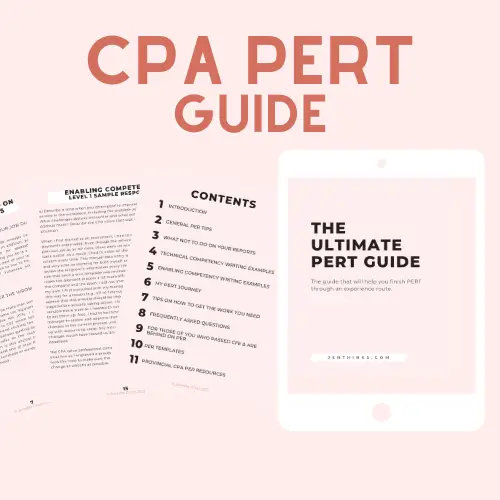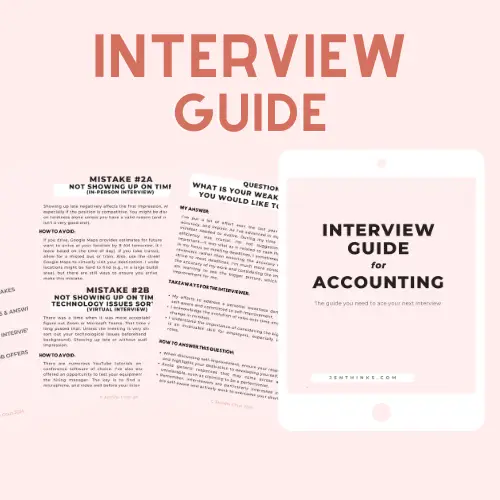I have been saying I will write a post on CPA PERT Enabling Competency examples for weeks now. The more I want to write it, the more I dread writing it. I have a love/hate relationship with my PERT posts. On one end, I know how much you all appreciate me sharing my experiences with PERT (both successes and failures). On another end, I can’t help but worry about giving out misleading/useless information. I was just talking to a friend the other day about how we did not get a warning about the difficulty with PERT. Even though I have not written the CFE, I have been convinced by the experiences of many others that PERT via EVR can be harder (to some, much harder) than passing CFE.
RELATED POST – CPA PERT – Technical Competencies Examples
However, as with all of my CPA posts, I am sharing my experiences in hopes that they can help you in some way. Note, these experiences were reported before the changes effective Apr 1, 2021, were in effect for CPABC candidates. Also, my experiences are meant to help inspire you to reflect on your own experiences and try to connect them with the applicable competencies. I am obligated to remind all of us that CPA takes plagiarism very seriously.
Read all CPA PERT posts here.
What Positions Did I Get These Enabling Competency Experiences In?
I got these Enabling Competency experiences working as an AP Clerk for a software company and as a Corporate Accountant for a telecommunication company. I talked about the possibility of getting PERT-qualifying experiences in entry-level accountING jobs such as AP in my previous technical competency examples post. For enabling competency, I want to stress that it is even more achievable to get at least level 1 for them as they are focused on self-reflection and soft skills (e.g., teamwork, self-management). You might not be able to prepare financial statements as an AP clerk (though, in my case, I did get the chance to prepare a couple of smaller parts when I worked in AP), but you will definitely have the chance to work with a team or communicate with people from a different department than your own.
CPA Values
Reference: CPA Ontario
Before I dive into my examples, here are the five CPA values. These will be useful to you as most of the enabling competencies ask you to describe the CPA value that was most applicable to your situation.
- Professional Behaviour
- Integrity and Due Care
- Objectivity
- Professional Competence
- Confidentiality
Are you looking for a comprehensive guide for PERT with example Level 1 & 2 full responses, tips, templates and more? Check out my CPA PERT Guides!
CPA PERT Enabling Competency Examples
Solving Problems and Adding Value (Level 1)
Task: I had to make a wire payment to a foreign country as the commencement of a construction project was dependent on payment receipt; the challenge was the wire got rejected multiple times for unknown (at the time) reason
Level 1 Submission
Obviously, making a straightforward international wire payment is nothing to write home about. As an AP clerk, I made over 1,000 of those. However, I reported on this example as it was complicated (due to the rejections), time-sensitive (the construction project was dependent on it) and required coordination with multiple stakeholders (finance and another department). I first identified the problem I had to solve (basically to get the money to the recipient), the stakeholders involved (finance, the other department for whom the project was for etc) and the steps I took to resolve it (leveraging my own knowledge and assistance from the bank). I further discussed the impact of my actions and what I learned from this (stay calm and keep everyone informed).
Solving Problems and Adding Value (Level 2)
Task: the finance team did not have established deadlines set for employee expenses submission; as a result, finance often had to process late-submission to include the reimbursement on the next payroll
Level 2 Submission
I first identified the issue (the unnecessary stress on the finance team as we often had to process expense reimbursements that were submitted and approved last minute). I then detailed my analysis on the potential solutions I came up with (description of the solution and its pros and cons). After that, I explained the rationale behind my recommendation which was ultimately accepted by my manager. In my response, I made sure I tie the applicable CPA value in. As with most enabling competencies, I also discussed the impact my action had on my company and also what I learned from my experience.
Managing Self – Engages in Professional Development (Level 1)
Task: career goals in the next 3-5 years and how to achieve them
Level 1 Submission
Since this one will vary widely from person to person, I will share how I structured my response instead. First, I listed out my career goals in detail. For example, I set a goal of getting promoted from Senior AP Clerk to AP Lead in the next 6 months and writing my CFE in the next year. I then talked about where I intend to be after that. I followed up with specific actions I have taken to get there. For example, by performing at a consistently high level and accepting extra work to increase the scope of my abilities. I then outlined my action plan for the foreseeable future that aligns with achieving those career goals (discuss then with my manager).
Communicating – Adapts Communications to Meet Audience Needs (Level 1)
Task: creating an online training deck for employees joining the AP team as we switched to work from home full-time and in-person training was no longer possible
Level 1 Submission
I first identified the reason why this training deck was required (work from home, new member on the team). I then discussed why I had to make sure my presentation fit the needs of the audience (someone with limited knowledge of the company, operations and finance). I outlined the steps I have taken to ensure the presentation was user-friendly, contained sufficient information and easy to access. I also discussed the impact not having this online training deck would have on my team and the department overall. Lastly, I reflected on what I learned from this experience.
Collaborating and Leading – Plans And Effectively Manages Teams And Projects (Level 1)
Task: my manager asked for assistance on a last-minute audit request that was mission-critical while my team was short-staffed and were scheduled to work on other tasks already
Level 1 Submission
I detailed my steps on trying to understand the urgency of the task (found out it was mission-critical to the audit hence it had to be completed that day), coordinating with the rest of my team (found out what was on everyone’s agenda) and assessing our priorities (some of the tasks scheduled to be done that day can be postponed). I then explained how I got approval from my manager’s manager to complete the task in a way that was more efficient while meeting the auditor’s request. I shared what I learned from this experience (the importance of working with the team and reassessing priorities as needed) and how my company benefited from my action (audit request was completed on time despite the short notice).




Comments are closed.